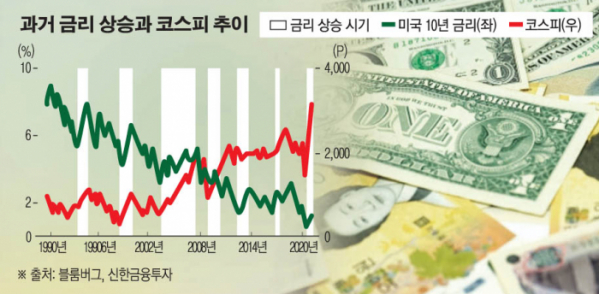
(Graphic = Reporter Son Mi-kyung sssmk@)
While the US Treasury bond rate has recently risen due to increased fiscal stimulus and inflation expectations, it has exceeded the year-round high. Concerns are emerging.
According to the financial investment industry on the 15th, on the 12th (local time), the US 10-year Treasury bond exceeded 1.20%, and the US 30-year Treasury bond yield exceeded 2.0%. The U.S. 10-year Treasury bond rate reached the highest year-round, and the US 30-year Treasury bond rate also surpassed 2% for the first time since the novel coronavirus infection (Corona 19).
There are concerns that the burden of’debt-fed’ ants will increase as the possibility of inflation (increased inflation) and stock market adjustment increases due to the rise in US Treasury yields. The credit transaction loan balance surged to 21,6331 trillion won on the 25th of last month, recording a record high, and as of the 9th, it is recording 21,631.4 billion won.
First of all, when US Treasury rates rise, foreign investors want to buy safe Treasury bonds instead of stocks or high yield bonds. If that happens, the possibility of the dollar turning to strong as the money flows back to the US, and the attractiveness of the stock market in emerging countries such as Korea, which has enjoyed the supply and demand of foreigners in the weak dollar, could disappear. In fact, in April 2018, the U.S. 10-year Treasury bond rate rose from 2.761% to 2.999% in a month, and the amount of foreign net selling in the KOSPI at the same time reached the highest level in five years.
In addition, if the US Fed tapers (quantitative easing) in earnest to catch inflation, the rise in the base rate may increase, creating an environment that is unfavorable for risky assets. In addition, if the Bank of Korea raises its base interest rate, the interest burden of individual investors who have invested in debt increases.
However, there are many opinions that experts believe that the US interest rate has started to skyrocket, but it is not at the stage of putting a heavy burden on the stock market. This is due to the analysis that the rise in interest rates reflects economic robustness and sustainability rather than concerns about inflation. In addition, the prospect that the Fed will not change its stance in a tighter position is dominant.
“The reason the impact of the interest rate rise does not extend to other financial markets is that the outlook for the US economic growth rate is rising.” It is unfavorable, but the impact on other financial markets, such as stocks, is sufficiently offset by raising expectations for growth.”
Kang Song-cheol, a researcher at Shinhan Investment Corp. also said, “I usually think that an increase in interest rates is a factor that lowers stock valuation, but interest rates have risen even in the past economic recovery period. It is similar to the period when interest rates rose after the 2008 financial crisis or the 1998 foreign exchange crisis in that it was a recovery period and the market interest rates and expected inflation were low.”
